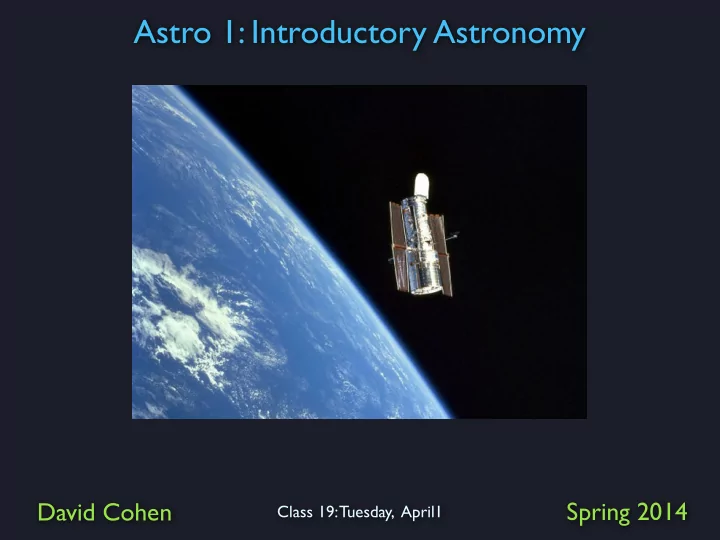

Astro 1: Introductory Astronomy David Cohen Spring 2014 Class 19: Tuesday, April1
Transits (left) for the planet’s radius and Doppler shift measurements (above) for the planet’s mass
Kepler Mission (2009)
With the masses of these planets found from their radial velocities, their densities can be calculated (next slide)
The density trends make sense, but note some low density Jupiter-mass planets - they’re hot and bloated because they’re near their host stars
secondary eclipse: the planet going behind its host star
secondary eclipse: zoom-in - see how the brightness goes up before the eclipse? the planet is reflecting the most light right before the eclipse
In our own Solar System, Venus reflects different amounts of light depending on its position in its orbit (too)
Summarizing
Exoplanet atmospheres can be detected during transits schematic of spectroscopy of the atmosphere, as the starlight shines through it during an eclipse
You can also think of this in terms of regular transit considerations The planet effectively has a bigger radius when you look at wavelengths at which its atmosphere is opaque vs.
multiplanet systems (left); Note (below) lighter planets are discovered as time goes on.
The Sun: stars have surface brightness variations. This limits the precision with which transits and Doppler shifts can be measured.
Limb darkening...plus sunspots and a transit of Venus
Exoplanet summary Exoplanets are common Many systems have planets very close to their host stars These “hot Jupiters” seem to have formed farther from their stars and migrated inward
Direct imaging of exoplanets will be common someday (probably)
Now let’s start on telescopes
The Hubble Space Telescope – 200 km above the Earth, but it makes all the difference: above the distorting effects of the atmosphere
In the public imagination, telescopes are refractors (i.e. have lenses) This tends to make them very long.
There’s a physical limit to how big a telescope can get…without bending the tube or stressing the lens. Yerkes refractor: world’s biggest with a 40-inch lens
Biggest telescopes are all reflectors (mirrors, not lenses) The light can bounce back and forth several times; they don’t need to be as long
Huge telescopes are built only at the best sites: high altitude, dry air. Also, images from two big scopes can be combined, effectively making one huge telescope (albeit with a strange- shaped mirror).
Kitt Peak in Arizona: More than ten telescopes, including the National Solar Observatory
No astronomers put their eye up to a research telescope these days… Collect data on electronic detectors, such as this charge- couple device (CCD) (same type of detector as those in commercial digital cameras). r e t e m i l l i m 1 Magnified image of a CCD. Each little square is a pixel, in which photons get converted to electrons, which can be counted, or “read out”
The Hubble Space Telescope – 200 km above the Earth, but it makes all the difference: above the distorting effects of the atmosphere Also able to observe infrared (IR) and ultraviolet (UV) light, which is absorbed by the atmosphere.
Now for some slides on refraction which is the basis for how lenses and telescopes work
Since refraction bends light, but the total amount of light must be conserved, refraction by real objects tends to make patterns of light and dark…
Where will the fisherman see the image of the fish?
Where will the fisherman see the image of the fish?
Where will the fisherman see the image of the fish?
Recommend
More recommend